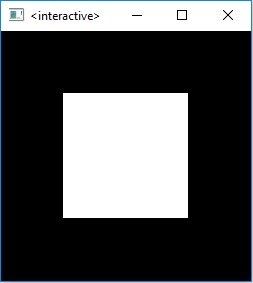
{-
Hello.hs (adapted from hello.c which is (c) Silicon Graphics, Inc.)
Copyright (c) Sven Panne 2002-2005 <svenpanne@gmail.com>
This file is part of HOpenGL and distributed under a BSD-style license
See the file libraries/GLUT/LICENSE
Hello.hs (adapted from hello.c which is (c) Silicon Graphics, Inc.)
Copyright (c) Sven Panne 2002-2005 <svenpanne@gmail.com>
This file is part of HOpenGL and distributed under a BSD-style license
See the file libraries/GLUT/LICENSE
This is a simple, introductory OpenGL program.
-}
-}
import Graphics.UI.GLUT
display :: DisplayCallback
display = do
— clear all pixels
clear [ ColorBuffer ]
display = do
— clear all pixels
clear [ ColorBuffer ]
— draw white polygon (rectangle) with corners at
— (0.25, 0.25, 0.0) and (0.75, 0.75, 0.0)
color (Color3 1.0 1.0 (1.0 :: GLfloat))
— resolve overloading, not needed in “real” programs
let vertex3f = vertex :: Vertex3 GLfloat -> IO ()
renderPrimitive Polygon $ mapM_ vertex3f [
Vertex3 0.25 0.25 0.0,
Vertex3 0.75 0.25 0.0,
Vertex3 0.75 0.75 0.0,
Vertex3 0.25 0.75 0.0]
— (0.25, 0.25, 0.0) and (0.75, 0.75, 0.0)
color (Color3 1.0 1.0 (1.0 :: GLfloat))
— resolve overloading, not needed in “real” programs
let vertex3f = vertex :: Vertex3 GLfloat -> IO ()
renderPrimitive Polygon $ mapM_ vertex3f [
Vertex3 0.25 0.25 0.0,
Vertex3 0.75 0.25 0.0,
Vertex3 0.75 0.75 0.0,
Vertex3 0.25 0.75 0.0]
— don’t wait!
— start processing buffered OpenGL routines
flush
— start processing buffered OpenGL routines
flush
myInit :: IO ()
myInit = do
— select clearing color
clearColor $= Color4 0 0 0 0
myInit = do
— select clearing color
clearColor $= Color4 0 0 0 0
— initialize viewing values
matrixMode $= Projection
loadIdentity
ortho 0 1 0 1 (-1) 1
matrixMode $= Projection
loadIdentity
ortho 0 1 0 1 (-1) 1
— Declare initial window size, position, and display mode (single buffer and
— RGBA). Open window with “hello” in its title bar. Call initialization
— routines. Register callback function to display graphics. Enter main loop and
— process events.
main :: IO ()
main = do
_ <- getArgsAndInitialize
initialDisplayMode $= [ SingleBuffered, RGBMode ]
initialWindowSize $= Size 250 250
initialWindowPosition $= Position 100 100
_ <- createWindow “hello”
myInit
displayCallback $= display
mainLoop
— RGBA). Open window with “hello” in its title bar. Call initialization
— routines. Register callback function to display graphics. Enter main loop and
— process events.
main :: IO ()
main = do
_ <- getArgsAndInitialize
initialDisplayMode $= [ SingleBuffered, RGBMode ]
initialWindowSize $= Size 250 250
initialWindowPosition $= Position 100 100
_ <- createWindow “hello”
myInit
displayCallback $= display
mainLoop


{-
Double.hs (adapted from double.c which is (c) Silicon Graphics, Inc.)
Copyright (c) Sven Panne 2002-2005 <svenpanne@gmail.com>
This file is part of HOpenGL and distributed under a BSD-style license
See the file libraries/GLUT/LICENSE
Double.hs (adapted from double.c which is (c) Silicon Graphics, Inc.)
Copyright (c) Sven Panne 2002-2005 <svenpanne@gmail.com>
This file is part of HOpenGL and distributed under a BSD-style license
See the file libraries/GLUT/LICENSE
This is a simple double buffered program.
Pressing the left mouse button rotates the rectangle.
Pressing the middle mouse button stops the rotation.
-}
Pressing the left mouse button rotates the rectangle.
Pressing the middle mouse button stops the rotation.
-}
import Data.IORef ( IORef, newIORef )
import System.Exit ( exitWith, ExitCode(ExitSuccess) )
import Graphics.UI.GLUT
import System.Exit ( exitWith, ExitCode(ExitSuccess) )
import Graphics.UI.GLUT
data State = State { spin :: IORef GLfloat }
makeState :: IO State
makeState = do
s <- newIORef 0
return $ State { spin = s }
makeState = do
s <- newIORef 0
return $ State { spin = s }
display :: State -> DisplayCallback
display state = do
clear [ ColorBuffer ]
preservingMatrix $ do
s <- get (spin state)
rotate s (Vector3 0 0 1)
color (Color3 1 1 1 :: Color3 GLfloat)
rect (Vertex2 (-25) (-25)) (Vertex2 25 25 :: Vertex2 GLfloat)
swapBuffers
display state = do
clear [ ColorBuffer ]
preservingMatrix $ do
s <- get (spin state)
rotate s (Vector3 0 0 1)
color (Color3 1 1 1 :: Color3 GLfloat)
rect (Vertex2 (-25) (-25)) (Vertex2 25 25 :: Vertex2 GLfloat)
swapBuffers
spinDisplay :: State -> IdleCallback
spinDisplay state = do
let wrap n s = if s > n then s – n else s
spin state $~ (wrap 360 . (+ 2))
postRedisplay Nothing
spinDisplay state = do
let wrap n s = if s > n then s – n else s
spin state $~ (wrap 360 . (+ 2))
postRedisplay Nothing
myInit :: IO ()
myInit = do
clearColor $= Color4 0 0 0 0
shadeModel $= Flat
myInit = do
clearColor $= Color4 0 0 0 0
shadeModel $= Flat
reshape :: ReshapeCallback
reshape size = do
viewport $= (Position 0 0, size)
matrixMode $= Projection
loadIdentity
ortho (-50) 50 (-50) 50 (-1) 1
matrixMode $= Modelview 0
loadIdentity
reshape size = do
viewport $= (Position 0 0, size)
matrixMode $= Projection
loadIdentity
ortho (-50) 50 (-50) 50 (-1) 1
matrixMode $= Modelview 0
loadIdentity
keyboardMouse :: State -> KeyboardMouseCallback
keyboardMouse state (MouseButton b) Down _ _ =
idleCallback $= case b of
LeftButton -> Just (spinDisplay state)
_ -> Nothing
— ESC not handled in the original example, but useful nevertheless
keyboardMouse _ (Char ‘\27’) Down _ _ = exitWith ExitSuccess
keyboardMouse _ _ _ _ _ = return ()
keyboardMouse state (MouseButton b) Down _ _ =
idleCallback $= case b of
LeftButton -> Just (spinDisplay state)
_ -> Nothing
— ESC not handled in the original example, but useful nevertheless
keyboardMouse _ (Char ‘\27’) Down _ _ = exitWith ExitSuccess
keyboardMouse _ _ _ _ _ = return ()
— Request double buffer display mode.
— Register mouse input callback functions
main :: IO ()
main = do
(progName, _args) <- getArgsAndInitialize
initialDisplayMode $= [ DoubleBuffered, RGBMode ]
initialWindowSize $= Size 250 250
initialWindowPosition $= Position 100 100
_ <- createWindow progName
state <- makeState
myInit
displayCallback $= display state
reshapeCallback $= Just reshape
keyboardMouseCallback $= Just (keyboardMouse state)
mainLoop
— Register mouse input callback functions
main :: IO ()
main = do
(progName, _args) <- getArgsAndInitialize
initialDisplayMode $= [ DoubleBuffered, RGBMode ]
initialWindowSize $= Size 250 250
initialWindowPosition $= Position 100 100
_ <- createWindow progName
state <- makeState
myInit
displayCallback $= display state
reshapeCallback $= Just reshape
keyboardMouseCallback $= Just (keyboardMouse state)
mainLoop

